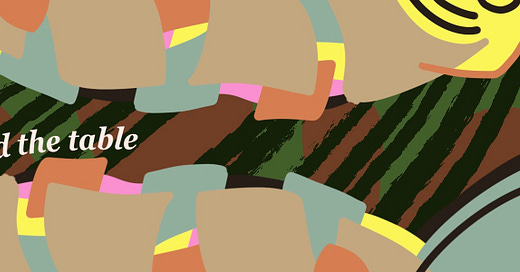Hi! If you can answer the question in the subject line, please skip this newsletter. If not, maybe take a quick read.
We’re on break this week (like actually - Jamie is on Spring Break). We’re all about taking necessary time off for R&R, so we will be resharing part of an old newsletter we sent out (+ a tiny Chef’s Special section). People (Americans especially) suck at geography, and we feel like it’s important to get your bearings on the world every once in a while.
Stay tuned next week for a piece on colonialism (part 1), partially prompted by this tweet:
Until then,
<3 Jamie and Melinda
Geography of Asia
What is Asia?
First and foremost, Asia is the largest and most diverse continent. Although conventional use of the term "Asian" is most often used to refer to those closer to the east (at least in the US - apparently "Asian" in the UK more often refers to South Asia), ALL these countries are in Asia: Afghanistan, Armenia, Azerbaijan, Bahrain, Bangladesh, Bhutan, Brunei, Cambodia, China, Georgia, India, Indonesia, Iran, Iraq, Israel, Japan, Jordan, Kazakhstan, Kuwait, Kyrgyzstan, Laos, Lebanon, Malaysia, Maldives, Mongolia, Myanmar (Burma), Nepal, North Korea, Oman, Pakistan, Philippines, Qatar, Russia (parts in Europe and Asia), Saudi Arabia, Singapore, South Korea, Sri Lanka, Syria, Tajikistan, Thailand, Timor-Leste (East Timor), Turkey (parts in Europe and Asia), Turkmenistan, United Arab Emirates (UAE), Uzbekistan, Vietnam, and Yemen.
What does "Asian American" mean (literally)?
According to the US Census, "Asian American" often refers to East Asians, Southeast Asians, and South Asians. What does that entail? (Note: The written terms encompass ethnicities, but the maps are primarily country-based. We tried our best to find exact maps, but there were few good ones that were fully labeled).
Southeast Asians - Bruneian, Burmese, Cambodian, Filipino, Indonesian, Laotian, Malaysian, Singaporean, Timorese, Thai, Vietnamese
South Asians - Bangladeshi, Bhutanese, Indian, Maldivians, Nepali, Pakistani, Sri Lankan
East Asians - Chinese, Japanese, Korean, Okinawan, Taiwanese, Tibetan
Our classic understanding of "Asian American" often also leaves out those considered part of Central Asia and West Asia.
Central Asians - Afghani, Armenian, Azerbaijani, Georgians, Kazakh, Kyrgyz, Mongolian, Tajik, Turkmen, Uzbek (Mongolia featured in the East Asia map)
West Asians - Bahrain, Iran, Iraq, Israel, Jordan, Kuwait, Lebanon, Oman, Palestine, Qatar, Saudi Arabia, Syria, Turkey (straddles Europe and Asia) United Arab Emirates and Yemen. NOTE: "West Asian" is actually a contested term because people often do not self-identify as "Asian", instead opting for a closer association with "Middle Eastern". At Penn (where Melinda & I went/go to school), Penn Arabs are part of the Asian Pacific Student Coalition.
What does Pacific Islander mean?
Pacific Islander refers to "(in the U.S. Jurisdictions & Territories) Carolinian, Chamorro, Chuukese, Fijian, Guamanian, Kosraean, Marshallese, Niuean, Palauan, Pohnpeian, Papua New Guinean, Samoan, Tokelauan, Tongan, Yapese". Often also included are Native Hawaiians. Check out our piece on why Pacific Islanders are grouped together with Asian Americans.
Why are they divided like this?
Like the continent of "Asia" itself, there is no historical consensus on the clear definitions of each "subregion". Historical accounts of the geographic determinations go back to Ancient Greeks and Romans, but the definition of "Asia" has changed over time. Some opt for a division based on tectonic plate configuration and others on the basis of ethnicity. For now, this is the dominant understanding of the continent and its regions. Make of that what you will...
What are our definitions leaving out?
There is an important distinction between the political/official states that are shown on the maps and the reality of "Asian American" experiences. A lil bit of that good human geo vocabulary bank - states are "independent, sovereign government exercising control over a certain spatially defined and bounded areas" while nations are "socially constructed units". US policy refers to "Asian Americans and Pacific Islanders" on the basis of country origin, but within each country, there are a number of diverse individual nations based on religion, ethnic identity, language, or cultural practices. Not all of these nations have associated states, and they can exist within a larger state that is predominately controlled by a different group. China, for example, contains over 56 different ethnic groups (a fact I actually first learned when I was studying for this Chinese examination, of which I have forgotten 99.9% of the contents). These include Uyghurs, Hmong, Zhuang, Han Chinese, and many more. Likewise, this diversity exists within each country, and these differences are not trivial!
Chef’s Specials 💋
🐉 Raya the Last Dragon came out on Disney+ (with the $30 additional price tag…). I generally enjoyed it - the story/characters were great and the art/animation was fantastic. Personally I’m still frustrated that Disney+ (at least in the U.S.) does not have any Asian language subtitles…



Criticisms I heard about the movie/Disney: (1) among the main characters, only Raya herself is voiced by a Southeast Asian person, Kelly Marie Tran, while most others are East Asian (e.g. Awkwafina, Gemma Chan, Daniel Dae Kim, Sandra Oh). (2) why is there that additional $30 price tag? Soul didn’t have it hmmm. (Mulan did too.) Anyhow, Kelly Marie Tran is amazing - pls check out this recent NYT piece on her (context: she suffered a lot of harassment due to her role in Star Wars, but now, “I’m not afraid anymore.” Here’s also an older 2018 piece she wrote.)
🐅 Did anyone else watch The White Tiger on Netflix? I was captivated the whole time and quite emotionally invested. As I’m obvi not South Asian and unfamiliar with the caste system, I’d love to know what folks thought about the film.














